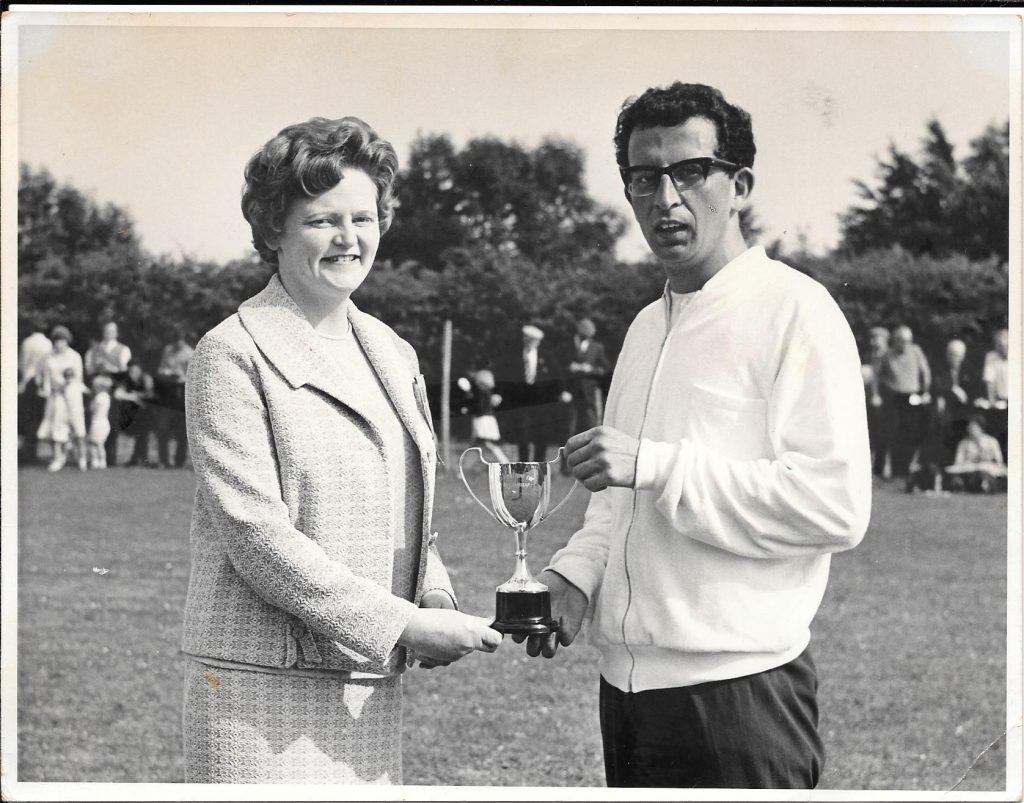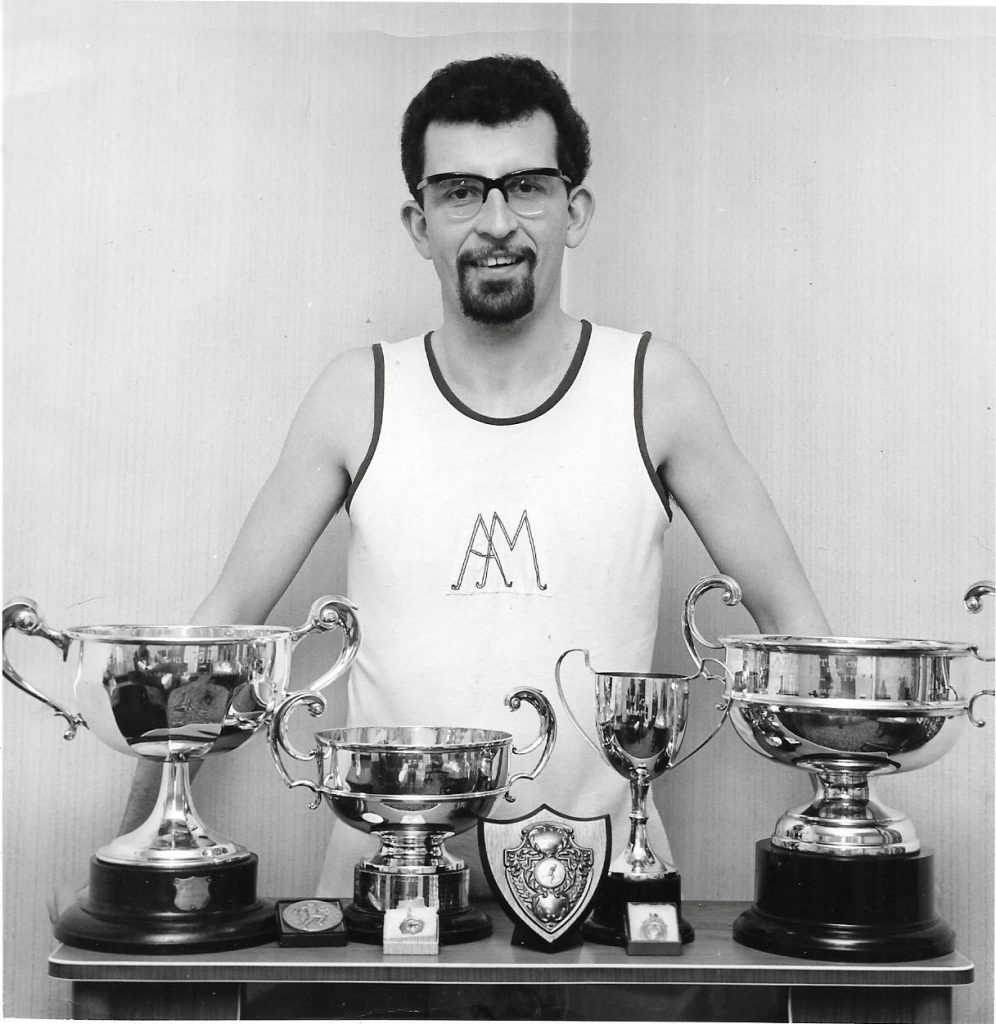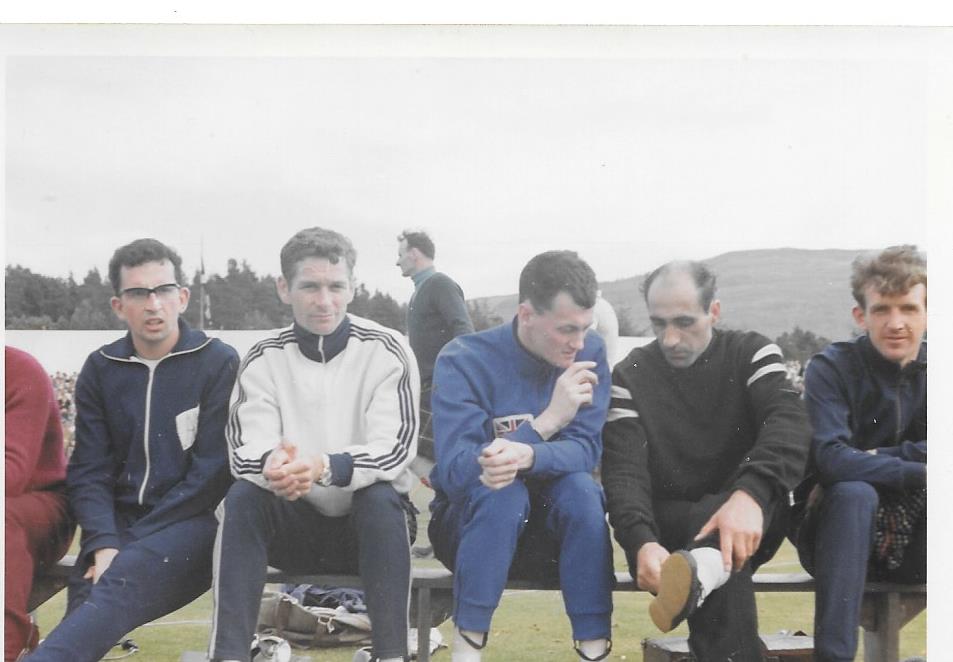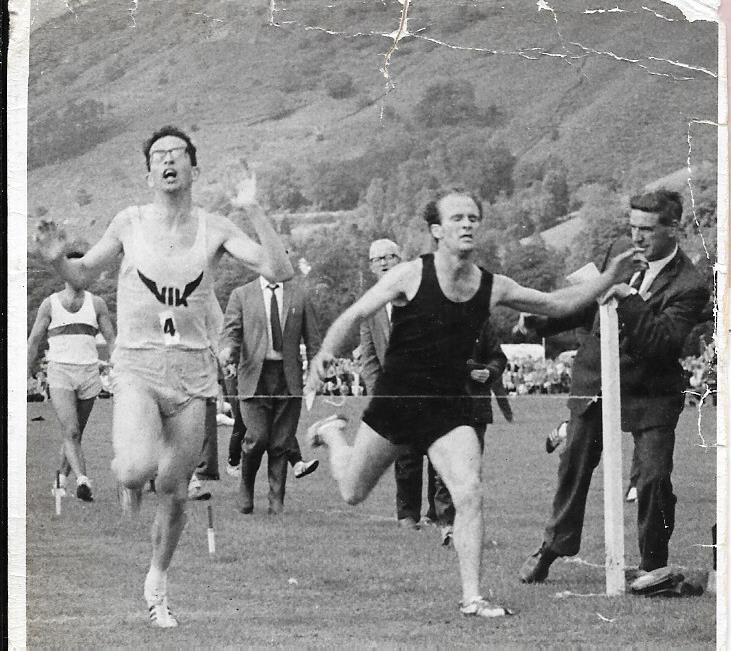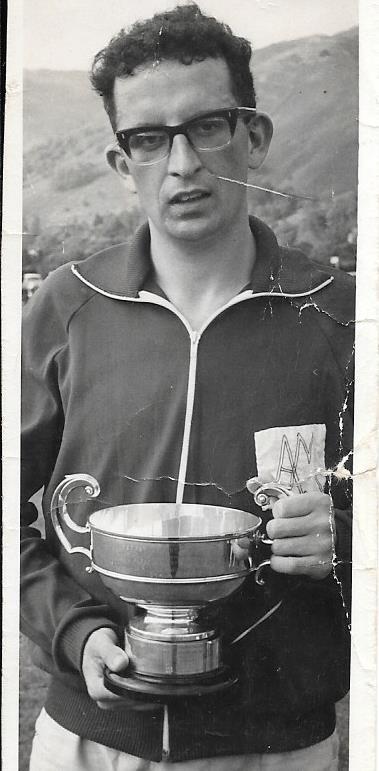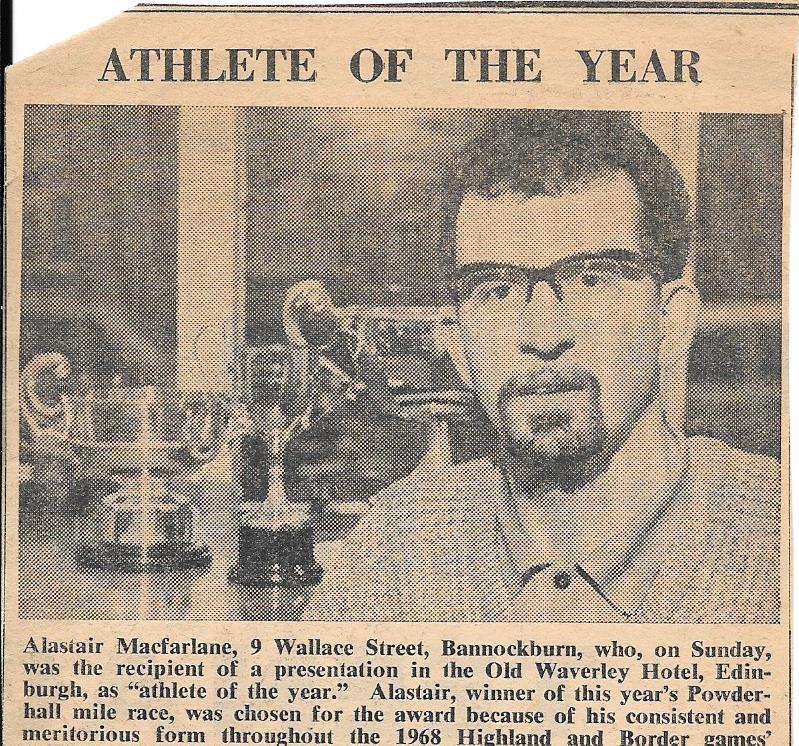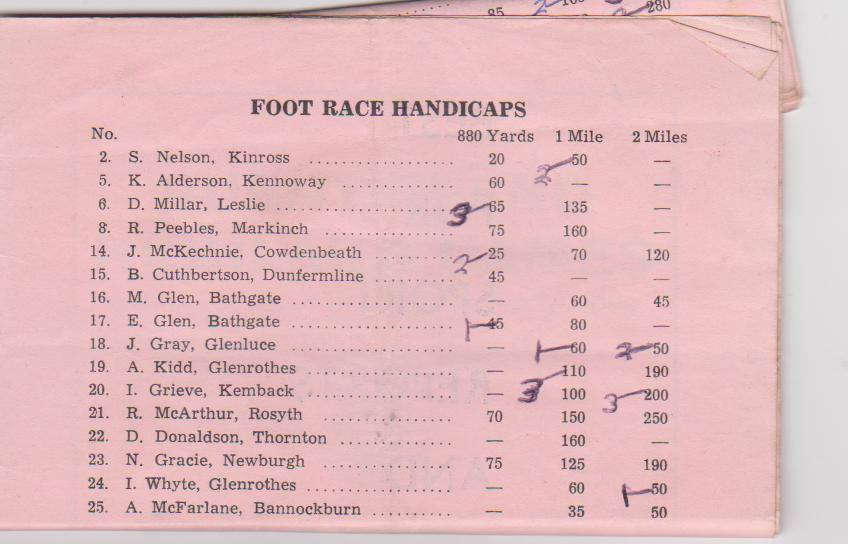Alastair Macfarlane was a revelation when he appeared on the Scottish amateur athletics scene in 1969 – well a revelation as far as the amateur athletics cognoscenti was concerned. He had been running consistently well since he was a boy in Bannockburn; as a pupil in the High School in Stirling, he was a member of the school team when they won the Joe McGhee Trophy for the first time. He also ran for the Boys Brigade. He first ran as a professional in 1965. In 1968 won the non-championship athlete of the year award having run well in the Borders, in England, in Fife, and in the West Highlands. He had as he later explained to Ron Marshall of the Glasgow Herald only ever regarded himself as an “amateur professional”.
In Colin Youngson & Fraser Clyne’s book “A Hardy Race” he explains his start in athletics and how he got involved in the professional circuit he ran initially with the St Modan’s Club and won a team medal at the national cross-country championships and then : ” Having left school, my commitment dwindled a bit although I had been doing some running with Willie Scott who ran in the professional highland games. Willie convinced me that what I needed to do was to join him on the pro circuit. At that time people like John Freebairn, Jimmy Bryce, Stuart Hogg and Eric Simpson, Arthur Rowe and the legendary Bill Anderson were all prominent competitors; and Olympics fourth placer Alan Simpson and former world mile record holder Derek Ibbotson were soon to join the pro ranks. After a couple of years experience I improved sufficiently to become one of the top performers in the middle distance events.
Alastair’s best year was almost certainly 1968 where he had twelve first prizes as well as numerous seconds and thirds. But these performances did not come suddenly – the previous year saw its own successes. At the end of May 1967 he won the mile at Blackford from a mark of 100 yards and at Alva one month later it was the half mile that he won from 50 yards.
At the end of the season he won both mile and two miles at Pitlochry with another half mile victory at Morebattle and the mile at Balloch in between. There were also good races at other games and the results progressed as the season went on. Alastair was training with the lads at St Mondans and he pays tribute to Charlie Meldrum and Graham Pearson for the help that he received. The results included the half mile at Alva (off 50 yards), St Ronan’s (55) and Morebattle (30), the mile at Blackford (100), Balloch (100) and Pitlochry as well as the mile at Pitlochry. It wasn’t just the other athletes who noticed, or the handicapper but the local papers all noted his running. For instance in the coverage of the St Ronan’s Meeting at Innerleithen, the race was described the following week as follows. “There was no holding Alastair Macfarlane, Bannockburn, when he raced away from the opposition in the half-mile to win in 1 min 52.4 sec. Coming into the last lap it looked as if I Thomson, Kincardine, was going to repeat the win he pulled off at Netherdale earlier this month. But Macfarlane, who is in his third season on the track never faltered when challenged. Eddie Glen,Bathgate, finished third, and Jimmy Hogarth, Cornhill, was fourth.”
And at the Morebattle Games in August, the reporter said: “Alastair Macfarlane of Bannockburn (30) came through with a well timed run over the last furlong to win the £15 half mile prize. Coming into the straight, Jimmy Hogarth, Cornhill 65, and Eddie Taylor Wallsend were contesting the lead. Then Macfarlane – who had held off Ian Whyte, Glenrothes 30, over the first two laps – sprinted up to challenge for the lead. Whyte also moved but could not break Macfarlane, who went on to win in a time of 2 mins. from Whyte and Taylor. “
He was being noted and his progress monitored in 1967.
With the added confidence gained from the 1967 season and a good winter’s work behind him, he started 1968 with a Two Miles win by three yards off a mark of 180 at the Blackford Games on May 29th in a time of 9:25. His first Mile victory of 1968 was at Hawick, on June 8th, when running from 100 yards he won in 4:10 quite comfortably from former Olympian and British record holder Alan Simpson. Simpson was now running as a professional and, unlike most amateur ‘stars’ who turned to the circuit when their best days are over, was still running remarkably well. He had just won the British half mile championship at this meeting in 1:53.9. This time the report read: “Alan Simpson did well to finish second in the one mile handicap to A Macfarlane, Bannockburn. In receipt of 100 yards start, Macfarlane went out to set a fast pace from the start. At the bell for the last lap he was still 45 yards in front. This was exceptionally good running from Macfarlane, winner over two weeks previous over the same distance at Blackford Games, but the time was much better at Hawick with the watch recording 4 mins 10 sec. When Macfarlane went through the tape Simpson was putting in a sprint finish to overtake Jack Knox, Selkirk, in the last 20 yards. This was the part of the race in which Simpson gained the admiration of the crowd. Over the five laps, Simpson ran many yards over the actual Mile in going round the field of runners. Early on in the race, Simpson (scr) put in a fast first lap to overtake the British champion J Brotherstone, Gordon. He did so at the 400 yards mark or so. It was a creditable performance.” The results for the Games meetings usually noted the prize money for the various events and Alastair’s winnings this time were £15: this compares with £15 (and the championship cup) for the British 880 yards Championship, and the open half mile money was £20. The report also spoke of Simpson having to weave his way through the field which had 87 entries but fortunately ‘only’ 46 ran on the five laps to the mile track. Alan and Alastair struck up a friendship which worked to their mutual benefit with Alan passing on some advice that he’d picked up in the international and invitational meetings he taken part in. The picture below was taken at Braemar – Alastair and Alan are on the left with Stuart Hogg, British champion professional sprinter and later international coach, in the blue track suit third from the right.
Next up was the Peebles Games on June 22nd. Again, Alastair was out in the mile, and again he won, this time from 85 yards, in 4:11.6, a victory described as ‘comfortable’ in the SGA Handbook. “Andy Macfarlane, Bannockburn, followed up his miles win at Blackford and Hawick – and two seconds at Selkirk – with a runaway win in the Peebles Mile. He won the £30 prize in 4 mins 11.8 sec from Powderhall runner-up Jimmy Gray of Glenluce. Macfarlane broke the field with some 300 yards to run. At this point Gray, Chris Renton of Hawick, and A Rae from Lockerbie, formerly Galashiels, were running together just behind TA Gray of Swinton. The Berwickshire runner was the limit man off 175 yards\qualifying in his heat behind Macfarlane and Renton in 4 min 14.6 sec. Alan Simpson, the former Olympic runner and AAA champion withdrew from the final of the mile. He ran second in his heat to Jimmy Gray and his decision not to compete for the £30 prize money came as a big surprise. Simpson ran a hard half-mile in a bid to to qualify, then turned out in the mile to qualify behind Jimmy Gray of Glenluce. Simpson said he had taken too much out of himself in the two earlier races. Border followers will be hoping that Simpson concentrates on the mile in future for the former amateur star is a great runner. He is the type of runner the crowd enjoys watching when he weaves his way up through the field. The mile was split up into two heats to give the back markers a chance.” On the amateur programme, it was always the case that a runner qualifying for the final of one event, could not compete in the heats of another until after the final for which he had qualified. It would have saved these kind of problems. The Peebles meeting prize money was generally good and the £30 for the Mile looks good – until you see that the 100 yards Beltane Sprint prize was £150 which was a lot of money in 1968. There was a definite hierarchy in the Games with the Heavy Events having big money and trophies, then the sprints with many special races at the different Games meetings where some had a special 80 yards, others special races at 120 or 90 or 100, while the half mile, mile and two miles were generally not as well rewarded.
Alastair’s next victories in 1986 included Alva in the Hillfoots on 29th June, where he won both 880 yards, off 10 in 1:59, and the mile, also off 10, in 4:16 by inches * The SGA had a series of star awards for specially good runs which were graded from 1 to 5 stars. Alastair was awarded a star for the mile victory. He also won two events at Luss on the banks of Loch Lomond on 17th July – the mile, from 60, no time given; and the two miles, from 150, again no time given, and won by 3 yards. At Jedburgh on 13th July, there was bit of drama at the finish in which Alastair featured. Running from 50 yards in the Edinburgh and Leith Plate Mile handicap, he made a tremendous burst coming into the finishing straight but Jim Minto of Morebattle, off 160 yards, was clear in front then “the competition for the second prize of £10 was keenly contested. Macfarlane stumbled and fell a yard from the winning line and McGillivary was awarded second place. In what was a dramatic moment. Macfarlane had the presence of mind to roll over the line to get his feet clear for the third prize of £5.” The emphasis on prize money made good copy but these guys at that point of the race had no thoughts of money: they were wanting to beat the others to the winning post. Fourth man won £2 but he was running as hard as he could to catch the two men in front of him simply because he was a runner. Langholm was on Friday 26th July and he was less successful there – reported to have run a great race he was run out of the prizes. Virtual scratch man at 35 yards, he was beaten by Hawick YMCA rugby winger 17 year old Doug Scott (75) in 1:59.3 with the minor places being taken by Jim Minto (70) and T Gray (90). An interesting sidelight was that of the mile where Eddie Sinclair suffered a fate similar to Alastair’s when he ran well but was out of the prizes: in the not too distant future they would both be members of Springburn Harriers.
Just as for the amateurs the first Saturday in August was a very popular date in the professional calendar. For the amateurs it was Strathallan Gathering that was the draw, for Alastair and the professionals it was further south in Lauder where the Common Riding Games were held. In 1968 they were on 3rd August, and he was running in the invitation mile against the legendary Michael Glen, now nearing the end of his racing career and Jim Brotherston, former British champion and the man after whom the winning trophy was named. Report: “Alan Simpson, the former Olympic and AAA champion was, unfortunately, not entered for the one mile, short limit, handicap for the Brotherston Cup, but former holder of the one mile title, Jim Brotherston, Gordon, ran off scratch and he found it hard going against 22 year old Alastair Macfarlane from Bannockburn (16) . In the field of six runners, Billy Temple, Gala, (70) led the field over the first two laps with Macfarlane and former title holder Michael Glen, Bathgate (30) battling it out for supremacy. The lead changed hands three times over the last lap between Glen and Macfarlane. In the home stretch, Macfarlane got the edge over Glen, and his deceptive rolling style showed he is a very strong man indeed. Macfarlane finally went on to win in 4 min 15 sec, a time which made many shrewd judges of runners say that Macfarlane is the most important runner of this season, having won prizes at Hawick, Selkirk, Peebles, Jedburgh, etc.”
Michael Glen had begun running in 1944 when he was 11 years old and competed for the next 26 years winning all that could be won including the British Mile Championship in 1958. He was known to have started up to 30 yards behind the scratch line. He had been King of Middle Distance running in Scotland for many years. Click on his name for a proper profile. Alastair’s picture at the top of the page shows him receiving the race trophy.
Alastair winning at Grasmere
Next Games were at Morebattle, near Kelso, on August 16th. Alastair was off 45 yards in the Mile and among the opposition were Jim Brotherstone (35), and Michael Glen (60). The preview said that “After their thrilling rivalry in the invitation mile at Lauder, Alastair Macfarlane and Michael Glen renew rivalry. The game Stirlingshire runner meets the British record holder on five yards worse terms.” In the event, the result was a triumph for a man we have seen before winning from a big handicap. The same paper tells us “Despite being 30 yards ‘worse in’ for his Jedburgh success, J Minto, Morebattle (135) was never headed in the mile, and won from Macfarlane (45) and W Scott (Cowie, 170).” The winning time was 4:24.3.
Grasmere, held this year on 22nd August, was one of the top meetings of the year with a good track, a very picturesque setting. good crowds and excellent organisation. The headline was “SUNSHINE MADE THIS GRASMERE GLORIOUS” and the strap line below read Mile finish and fell race were highlights.” The meeting was a personal triumph for Alastair who won both half mile and mile. The report opened on his performances and said:
“A 22 year old ‘flying Scot’ stole the honours on Thursday at a Grasmere Sports Meeting which opened under a shroud of threatening cloud but was largely held in brilliant sunshine. On a day generally dominated by wrestlers and fell runners, the 10,000 crowd rose to Alastair Macfarlane, Bannockburn, as he put in a tremendous finishing burst to win the mile handicap. Cockermouth runner Brian Carruthers, who had led almost all the way could not resist the spectacular challenge from the Scotsman who snatched victory inches from the tape. The triumph, coupled with an earlier success in the half mile, earned Macfarlane the day’s top athlete award – the cup for the outstanding athlete of the meeting. It was only the second time the trophy had gone to a competitor in flat race events, the earlier holder from that category being Jeff Tinnion, Dearham, in 1959. Macfarlane’s brilliant running provided some of the most enthralling moments in a Grasmere which was somewhat featureless compared with those of recent years.”
The actual results were: half mile: 1. A Macfarlane(35); 2. S Nelson (Kinross, 20); 3. D Turner (Cleator Moor, 55). Time: 1:55 2-5th. mile: 1. A Macfarlane (60); 2. B Carruthers (Cockermouth, 190); 3. S Nelson (Kinross 50). Time: 4:15. Alastair was the first Scotsman to win the half mile at Grasmere and it was rated a two star performance by the SGA.
[There was a post on the ‘Memiours of Pro Athletics’ Facebook page that said: “Probably the best track on the circuit. Such a shame that they don’t have track races any more. Always a big crowd and a great atmosphere.” The equally famous Cowal Highland Games has also dropped athletics from its programme and some others have reduced the number of running events. ]
Alastair with the trophy for athlete of the meeting at Grasmere, 1968
After running in the North of England, it was back up to Perthshire for the next outing: Pitlochry, a ‘minor meeting’ accotding to the SGA handbook but a big one to those attending it, was held on the second weekend in September. Itis a meeting held on a good track, well supported and popular with the athletes. Alastair repeated his Grasmere form and had two victories he won the mile and two miles there to finish off the track season.
Having won races between 880 yards and two miles in all corners of the country, there was really only one big challenge left. That was the Powderhall Mile held at New Year. The headlines told the story: Powderhall had near legendary status and was always well covered. “MacFARLANE WINS AT POWDERHALL”, “P.O. MAN WINS AT POWDERHALL”, “POWDERHALL SUCCESS”, “Pedestrianism, WINNER’S CLEVER TACTICS” The last was from the Glasgow Herald which made it clear that the race was not an amateur promotion by giving the headline a pedestrianseparate headline! We were told that ‘Macfarlane was an outsider in the betting’, that he put in a terrific spurt in the last 50 yards, and so on but the most comprehensive report was the one in the Glasgow Herald: “Alastair Macfarlane, a post office engineer from Bannockburn, won the mile handicap at Powderhall on Saturday and proved himself a clever tactician. Macfarlane had finished a mediocre looking second in his heat to Stuart Tait of Cornhill who was made favourite for the finl and looked a good bet with a lap to go. But Macfarlane began to make his move in the last quarter, sped past the opposition, and won by two yards from Tait with ‘Fid’ Veitch another Borderer, third. Macfarlane was neglected in the market. His starting price was returned at 100 – 8, and a few backers secured 20 – 1.” He had survived Heat, Cross-Tie and Final to win in 4:23.2. There’s another difference in terminology – Heat winners under SAAA rules would contest a semi-final and final; under SGA rules the semi-final was designated a cross-tie. Alastair never bet at all, on himself or anyone else. Had he done so here, he might have done well.
Having won no fewer than ten mile handicap races over the year, plus several victories at the half mile (with Grasmere being outstanding) plus a couple of two mile prizes, he was named as the Games Athlete of the Year, 1968. The presentation of the award was made in the Waverley Hotel in Edinburgh on 16th March, 1969 and was awarded the trophy “in recognition of his consistent and meritorious form throughout the 1968 Highland and Border Games season.” There were many groups (or schools) of athletes training together under a coach around Scotland, but Alastair did not belong to any ‘school’. He trained on his own and with St Modan’s AC in Stirling. He paid tribute to this group in recognition of the help he had received from them, saying in the Stirling Observer. “I have to thank Charles Meldrum and Graham Pearson for early encouragement and help.” Shortly after the presentation he recognised the assistance given him by Alan Simpson.
One former pro athlete said that one of the difficulties the circuit had was the lack of a national organisation which set standards for the various aspects of the sport. One comment from a gentleman involved in the attempt said “I remember when we got together with the handicappers to try and standardise handicaps to eliminate the discrepancies with each handicapper as it was always the biggest complaint amongst athletes.” But there was a problem that the minute of the meeting setting the group up said: “We have met recently to try and come up with some uniformity in the marks of every athlete on the pro circuit. But I can also stress that such Games will still be handicapped by their own individual man, and so marks will not necessarily be the same at every meeting.”
One of the glories of the pro circuit is the individuality of the different Games but they were, in some ways, ‘too local’ from the athletes point of view. there was a problem in that different handicappers had different ways of working out the individual marks with each other. This was recognised and at one point a committee was set up with representatives from the various areas to talk about this among other things. “But however different ways there were of handicapping, Alastair’s successes of ’68 would automatically have him ‘pulled’ at every meeting in ’69. He never complained about it – it was part of the scene. If you won your handicap was cut, if you won well, your handicap was slashed. If you lost your handicap was increased.
Alastair, according to the SGA Handbook, did not win any of the races in 1969 that he had won in 1968. And at Powderhall he was handicapped at scratch.
The programme extract from the Burntisland Sports in 1969 shows how Alastair’s already low handicap was affected by the successes of the 1968 season. Virtual back marker in the Mile off 35 yards, his nearest opponents were Mike Glen and Sandy Nelson who were both 15 yards ahead at the start. The same Michael Glen was giving him five yards in the two miles which was more of a problem for Alastair than starting level or five yards down would have been.
As Ron Marshall reported in the ‘Glasgow Herald’ on 17th January, 1977, “Eventually Macfarlane’s summer benefit reached its twilight. Even his superior fitness fell prey to eagle-eyed handicappers, who would have been happy slapping a saddlebag of weights on this ex-amateur with the winning ways.” Possibly a bit hard on the handicappers but the truth is probably that he had not felt happy with the scene for several years before he made the switch back to amateur athletics.
You can read about his entire career at
where he talks freely about his time as a professional before he was reinstated and became Scottish marathon champion in 1979 and one of the country’s best road racers.
